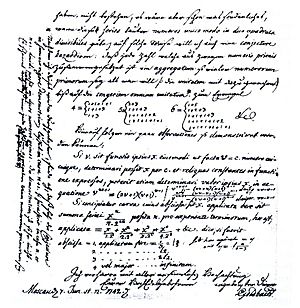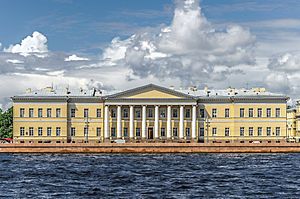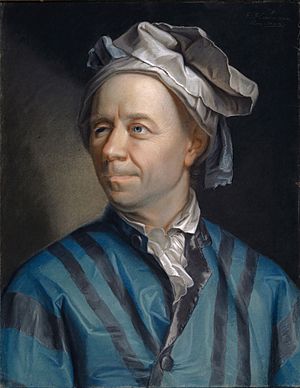Christian Goldbach facts for kids
Quick facts for kids
Christian Goldbach
|
|
|---|---|
| Born | 18 March 1690 Königsberg, Brandenburg-Prussia
|
| Died | 20 November 1764 (aged 74) |
| Nationality | Russian |
| Citizenship | Russia |
| Known for | Goldbach's conjecture |
| Scientific career | |
| Fields | Mathematics and Law |
| Signature | |
Christian Goldbach (born March 18, 1690 – died November 20, 1764) was a smart mathematician from Prussia. He is famous for his work in number theory, which is a branch of mathematics that studies whole numbers. He also studied law and worked for the Russian government.
After traveling across Europe, Goldbach moved to Russia in 1725. He became a professor at the new Saint Petersburg Academy of Sciences. He even helped lead the Academy for a while. Later, he worked for the Russian Ministry of Foreign Affairs until he passed away.
Today, Goldbach is best known for Goldbach's conjecture, a famous unsolved problem in mathematics. He was also a close friend of the well-known mathematician Leonard Euler. Goldbach's ideas often inspired Euler's own mathematical work.
Contents
Biography
Early Life and Travels
Christian Goldbach was born in Königsberg, which was then part of Brandenburg-Prussia. His father was a pastor. Christian went to the Royal Albertus University to study.
After his studies, from 1710 to 1724, Goldbach traveled a lot around Europe. He visited places like England, the Netherlands, Italy, and France. During his travels, he met many famous mathematicians. These included Gottfried Leibniz, Leonhard Euler, and Nicholas I Bernoulli. Meeting these brilliant minds sparked Goldbach's interest in mathematics. He even spent a short time at Oxford University in 1713, learning from scholars like John Wallis and Isaac Newton.
Joining the Saint Petersburg Academy of Sciences
In 1725, Goldbach moved to Russia and joined the new Saint Petersburg Academy of Sciences. He was hired as a professor of mathematics and the Academy's historian. As the historian, he wrote down what happened at every Academy meeting from 1725 to 1728.
At the Academy, Goldbach worked with other great mathematicians. These included Leonhard Euler, Daniel Bernoulli, and Johann Bernoulli. Goldbach also played a role in convincing Euler to focus on mathematics instead of medicine. This helped make mathematics a very important subject at the Academy in the 1730s.
Working for the Russian Government
In 1728, when Peter II became the Russian Tsar (emperor), Goldbach became his tutor. He also tutored Peter II's cousin, Anna. When the Russian court moved to Moscow in 1729, Goldbach went with them.
It was in Moscow that Goldbach started writing letters to Euler. These letters contain some of Goldbach's most important ideas in mathematics. After Peter II died in 1730, Goldbach stopped teaching but continued to help Empress Anna.
In 1732, Goldbach returned to the St. Petersburg Academy of Sciences. He also continued his work with the Russian government. He became the corresponding secretary at the Academy. Goldbach kept his important role in the Russian court even after Empress Anna died. In 1742, he started working for the Russian Ministry of Foreign Affairs. He was given land and a higher salary for his good work. In 1760, Goldbach created new rules for educating the royal children. These rules were used for 100 years. He passed away in Moscow on November 20, 1764, at the age of 74.
Christian Goldbach could speak many languages. He wrote his diary in German and Latin. His letters were in German, Latin, French, and Italian. For official papers, he used Russian, German, and Latin.
Mathematical Contributions

Goldbach is most famous for his letters with other mathematicians like Leibniz, Euler, and Bernoulli. His most well-known contribution is Goldbach's conjecture, which he wrote about in a letter to Euler in 1742. He also studied and proved some theorems about special kinds of numbers called perfect powers. One of these is the Goldbach–Euler theorem. He also made important contributions to mathematical analysis, which is a branch of mathematics dealing with continuous change. Goldbach also proved a result about Fermat numbers, which is sometimes called Goldbach's theorem.
Goldbach's Impact on Euler
Many of Goldbach's most important mathematical ideas, especially in number theory, are found in his letters to Euler. Their friendship lasted even when Goldbach moved to Moscow in 1728. They exchanged 196 letters over 35 years, written in Latin, German, and French. These letters covered many different math topics.
Goldbach was a big influence on Euler's interest in number theory. Most of their letters discuss Euler's research in this area. Until the late 1750s, Euler mostly talked about his number theory research with Goldbach.
Goldbach's early math work and ideas in his letters directly influenced some of Euler's discoveries. For example, in 1729, Euler solved two math problems that Goldbach had found difficult. Euler then explained the solutions to Goldbach. Also, in 1729, Goldbach came very close to solving the Basel problem. This made Euler interested, and he soon found the breakthrough solution.
Through his letters, Goldbach kept Euler focused on number theory in the 1730s. They discussed Fermat's conjecture, another famous math problem. Euler later offered a proof for this conjecture and gave credit to Goldbach for introducing him to the topic. Euler went on to write many papers, and Goldbach's influence guided some of them. Goldbach's famous conjecture and his letters with Euler show that he was one of the few mathematicians who truly understood complex number theory.
Works
- (1729) De transformatione serierum
- (1732) De terminis generalibus serierum
See also
 In Spanish: Christian Goldbach para niños
In Spanish: Christian Goldbach para niños



